-

-
- 2009 Film Review - Watchmen
-
-

-
- April 1,
2009
- By Eric M. Scharf
-
- "The Media Magnate" has been a comic book fan for
years, particularly of those books that successfully marry quality
visuals and robust story-telling, filled with one gut-wrenching
irony after another . . . where vulnerability and humanity are always
right on the heals of the impossible and the unimaginable.
The Media Magnate has been waiting for just as many years to see the film industry
finally develop the nerve or be convinced of the financial
incentive to begin bringing many of the grittier, more mature,
comic book-derived themes to the silver screen.
The desired transformation began the moment the
Green Goblin cut Peter Parkers forearm in Sam Raimi's Spider-Man
in 2002 showing fans everywhere that superheroes are susceptible
to (all or instances of) the dreaded human condition, sometimes
being vulnerable (to paying rent, being late for a date, or
desperately needing a haircut for that date) and for all their
incredible gadgets, impossible super powers, and escapist hideouts
can be generally affected like much of society.
Batman Begins arrived in 2005
supplanting fan favorite Michael Keaton's 1989 portrayal with a
slick, substantive Bruce Wayne . . . and a dynamic, deadly Dark
Knight. Christopher Nolan treated all but the most
emotionally-challenged to a long overdue departure (or Warner
Brothers apology for and) from Joel "Extra Cheese" Schumacher's "Batman
Forever" and "Batman & Robin." Moviegoers see Christian Bale's
interpretation (of the billionaire businessman) struggle to come to grips
with his own mortal limitations in being unable to protect those
closest to him, even with all of his inherited financial might. He
discovers his ultimate solution, however on his way down a
destructive and terminal path which allows him to combine his
formidable fighting skills and material resources while requiring
only one 'small' thing of himself: become more than human without becoming
inhuman. Can he maintain enough clarity to remember where to draw
the line between being a vigilante hero for the people and becoming
the very villain(s) he has sworn to stop? How dark will he become?
The Dark Knight, indeed.
300 bludgeoned its way into our lives in 2006, taking grit to an
entirely new level and creating a potential new wave of history
teachers, even if the history portrayed in this film was admittedly
enhanced for our pleasure. The mere existence of this film alone with all of its bare feet and bloody battles
is convincing enough that moviegoers will be none-the-poorer if
they never see another brazen blood bath of a horror film
again.
The term 'graphic novel' will never again simply be defined as a
bigger and better extension of good ol fashioned comic
books. Everything about a graphic novel from the length of story
to depth of plot to richness of
characters to quality of inking to pop of color to physical size to
price to
quality of paper (for both cover and pages) is and will continue to be different and
greater.
Other comic book-based films such as Iron Man in 2007 have taken a
milder-but-still-potent approach in adding to the film industrys 'personal growth' experience.
Not all comic
book-to-film adaptations to be clear (need to) involve urgent,
Thunderdome, survival of the fittest scenarios in order to better
bring them to life. The
more variety in film adaptations to match the variety of
their comic book source material the better.
The Media Magnate 'simply' wishes to watch
one (or more, many, MANY MORE) of these adaptations and leave the theater believing that these
stories, events, and characters are even reasonably possible, especially in the case of a investigation-minded, physically fit,
hand-to-hand combat-ready, weapons-trained human dressed as a costumed crime fighter. And who
among the millions of comic book (and billions of feature film) fans would not wish for the same
thing?
No such comic-book-adapted film, however, has yet gone for the gusto in the same way as has
been achieved by "Watchmen." There was plenty of incentive to see this
film and considering the same director who helmed 300, Zack Snyder,
was steering this ship there was additional intrigue to see if Mr.
Snyder would, again, push the dirty, grimy envelope or acquiesce to
film execs fearful of an always-possible public backlash for
(GASP!) another R-rated graphic novel adaptation.
After all, there is always
someone 'out there' who will be screaming Is it not enough that we
know good ole Dagwood likes big sandwiches? Do we really want to
know the kind of mammoth meat contained in his sandwiches, too?
Why, yes, WE DO.
The Media Magnate had only once read through the 1986-1987 "Watchmen"
12-issue comic book mini-series (written by Alan Moore,
penciled-and-inked by Dave Gibbons, and colored by John Higgins) before seeing the
Hollywood
embodiment. The resultant vague memories allowed for viewing the film
with an open mind . . . minus the pre-existing paperback
postulations which have historically haunted so many silver screen
successions.
While Gibbons and Higgins quite
appreciated and enjoyed Zack Snyder's adaptive (and collaborative)
effort to bring their illustrative work (further) to life, Moore planned to "spit venom all over" Hollywood's handling of one
of his most fan-cherished stories. Moore has long-standing legal and
philosophical issues with DC (and in turn Warner Bros), and
Snyder no matter his very best and most respectful of intentions
was going to be collateral damage.
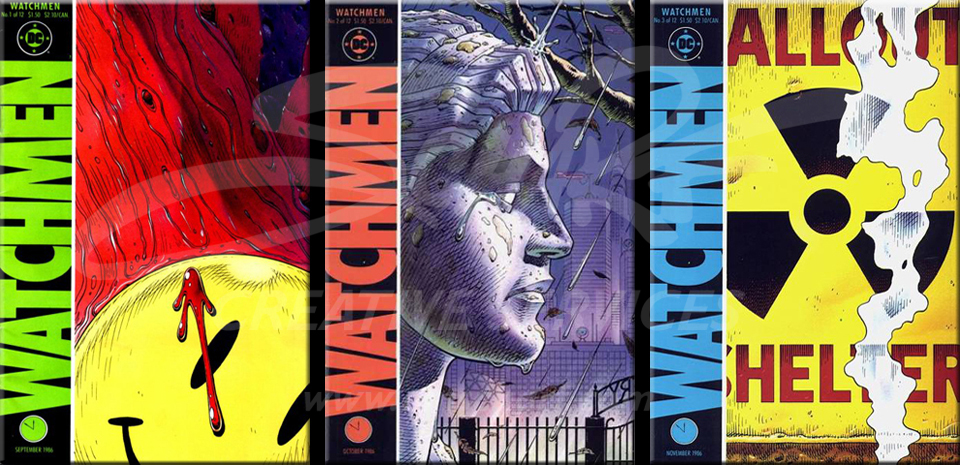
-
-
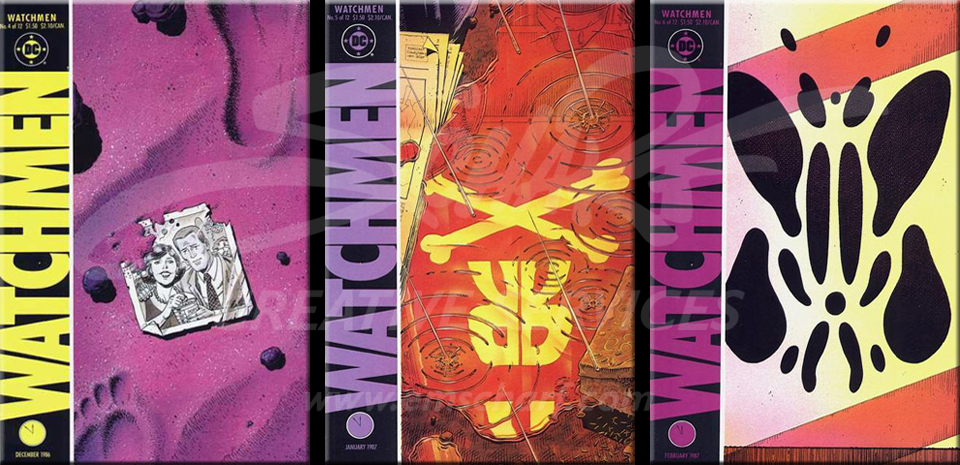
-
-
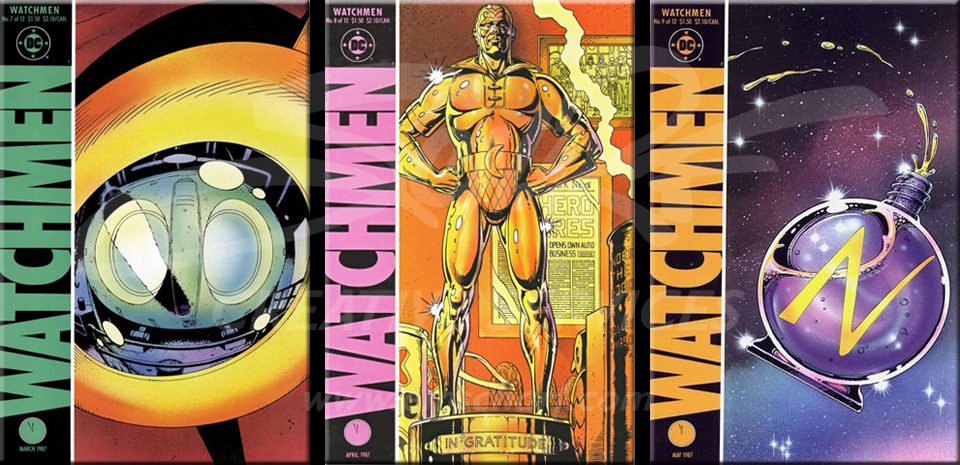
-
-
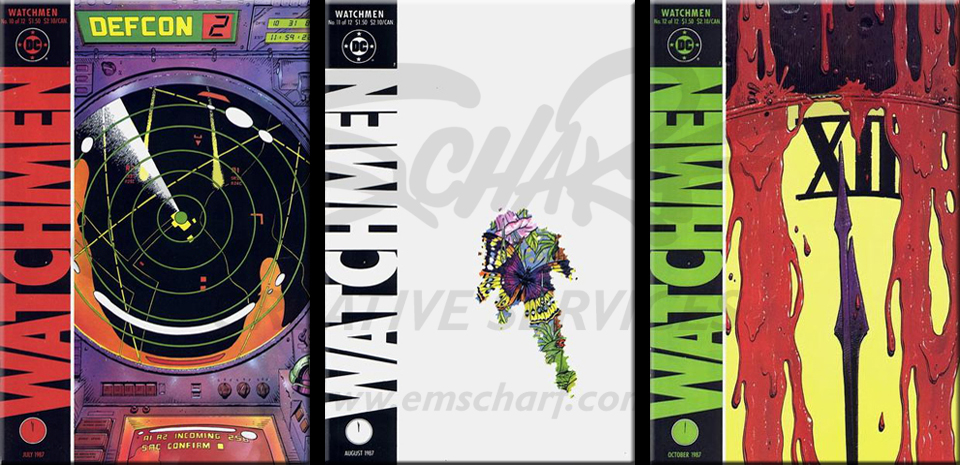
-
-
-
Before delving into the films story (or in the case of "Watchmen"
group psychological evaluation), the visual
quality is rich and vivid, delivering a satisfyingly immersive
experience, with characters you can reach out and grab, grimy
surfaces you can touch, blood, sweat, and tears you can feel, jet
fuel and bad breath you can smell, and gritty, emotionally-charged
voices you can hear, not to mention the near panel-for-panel
match to (most of) the original material.
The mix of slick-modern superhero costumes and
trench(coat)-level 'get it done' outfits is a nice departure from
the sterile, (almost) always-clean costumes on display within the
current "X-Men" film series. Some heroes absolutely need to look the
part while others (in sensationally soiled civvies) just look at you and say, Bring it.
But enough about the "sugar-coated topping" as Marvel's "Blade"
once said, and onto the
underbelly.
"Watchmen" takes place in an alternate universe in 1985, where the
United States is still embroiled in the Cold War with the U.S.S.R.,
Nixon is still President of the United States and with term limits
abolished in part due to his success in Vietnam he is on his fifth
term in office.
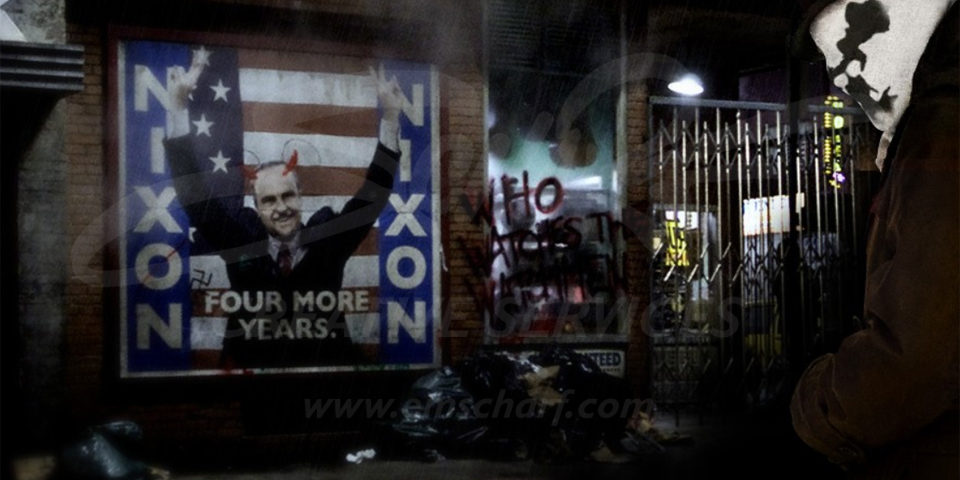
-
-
-
Tensions are as high as most Americans can remember,
the doomsday clock is set at five minutes to midnight, and
nowhere in sight is the statement Mr. Gorbachev, tear down this
wall!

-
-
- Vigilante superheroes in the flashback lead-up to 1985
happened on
the scene and grew in prominence from 1940 through 1960, culminating
in their much-needed participation in the U.S. winning the Vietnam
War. Soon after, the superheroes learn that unless they are willing
to work for the U.S. government they will effectively be legislated
into retirement through the Keene Act. War-time appreciation when
it exists continues to have its limits.
The plot is established in the midst of this forced retirement, when
an established super hero-turned-U.S.-government-mercenary Edward
Blake / the Comedian (played by Jeffrey Dean Morgan) is brutally murdered. He puts up a valiant fight, but
he is overmatched by a masked intruder who tosses the Comedian through the plate-glass window of his
own high rise apartment, leaving a bloody mess on the street below, which prominently sports one of his patented smiley face pins, stained with
the Comedian's "bean juice," and tormenting his colleagues one final time.
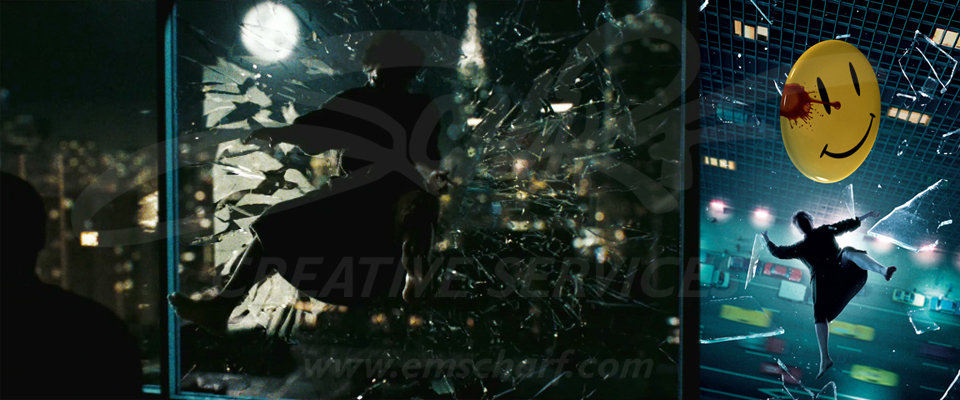
-
-
- The Comedian as we come to understand him
is far less a literal
comedian (with whom his colleagues can laugh at the expense of a
common enemy), and far more a complete jackass who with his
Punisher-like combat skills always seems to go two steps further
than his government-issued orders require, and who mercilessly hee-haws at
the misery his actions cause. He has no hero complex, goes
to work with a smile on his face, and does not take kindly to anyone
expecting him to take responsibility for his actions.

-
-
- Nonetheless, torment turns to paranoia as
all but two members of the former
Watchmen are on high alert about their own safety even with their
secret identities hidden away in
retirement with the most incorruptible and relentless of them all,
Walter Kovacs / Rorschach (played by Jack Earle Haley), leading the search for a
possible super hero serial killer or an organization of
killers.
It is
only fitting for the most strong-willed of "The Bad News Bears" to make his
triumphant return to the silver screen as the equally-willful and
undeniable Rorschach.
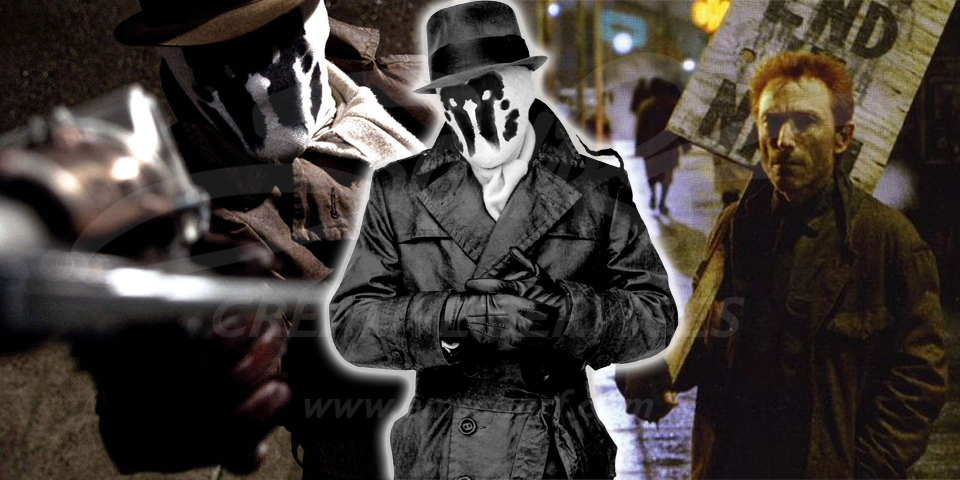
-
-
- The film adaptation of one of the most celebrated graphic novels of
all time at this point is already drowning in grit, keeping the
pedal to the metal for the duration, with the not so subtle reminder
that time waits for no one . . . and no good or bad deed ever goes unpunished.
Ferris Bueller once said, Life moves pretty fast. If you dont stop
and look around once in a while, you could miss it.
The further Rorschach digs, the clearer the murderous trail becomes,
the faster each event unfolds, and the more on-edge the Keene
Act-defying vigilante heroes (and moviegoers alike) become. The sad irony is that
while
the Watchmen are determined to find the answer for their fallen comrade and
obligated to protect themselves from the very same fate the closer
the heroes get towards the source of their troubles, the more they
question their collective purpose, and the less they like what they
find.
The Watchmen have only each other to relate to and
rely on in a world not at all richly endowed with super
heroes. Each of them is desperate in their own way to grab onto
something that is more than just their now-fragmented team, to
belong to something that represents more than just an association of
oddballs, and hold on for dear life (which is a common thread that
weaves together most-but-not-all superhero stories).
And their government-enforced exile, essentially, displaces
all of them, creating an internalized
tension that grows by the
day.
The Comedian being a government-sponsored hero is not restricted
by the retirement rule, but he contributes to his teammates
difficulties early and often, far in advance of his death. He
follows his orders with such single-minded (and admittedly reckless) focus that by the time he finally
comes to grips with what he has 'accomplished' on his missions it
is too much for him to digest all at once, causing him to
crack, spill secrets (to a retired super villain no less), and unknowingly triggering his own termination. Live hard and die hard(er).
Rorschach by (extreme) contrast has never been empowered by
government-funded opportunities to fight crime, whether as an
officially approved
superhero or as a vigilante for whom authorities occasionally
turn a blind eye in order to keep their hands clean(er). Rorschach
has only ever been energized by his all-consuming perspective of
humanity as moral or immoral, black or white, with rapidly
diminishing interest in the circumstantial gray. While Rorschach's miserable childhood forged
his fractured foundation, the life event that pushes him completely over the edge involves
a kidnapped little girl he is unable to save from being dismembered by her
captor (who then feeds her remains to a couple of man's best friends).
There is stifling irony in Rorschachs world view of humanity as the
single greatest obstacle to his mission of cleansing Earth of
immorality. The level of purity he
insists on seeing from imperfect beings could not exist in any form that would
reasonably satisfy his definition. If Rorschach
allows himself a moment of clarity to see his cleansing mission of
going from 'one ivory tower to one street corner at a time' will
never end especially with potential interference from one or more
of the Watchmen he
would practically beg to be put out of his misery.
Rorschachs perspective on humanity makes for an odd-if-intriguing
pairing with someone he considers a good friend, his best friend,
and perhaps his only friend in Daniel Dreiberg / Nite Owl (II),
played by a real hoot in the rangy Patrick Wilson. They both
prefer to first investigate a given crime scene, but the
approach is where their similarities end. They both excel in deadly
hand to hand combat, but the compact Rorschach is much more of a bruiser while the
larger Nite Owl is more of a
tactician. They appear to accept
each other without much precondition and without much verbal
acknowledgement they tend to agree to disagree (and agree again)
on how to best engage the very people they have vowed to protect
from evil. Yin and yang, manage and maim, read and react.
Nite Owl and Rorschach.
Two key scenes when tensions
are already particularly heightened perfectly demonstrate their
demented portrayal of "Laurel and Hardy."
The first scene occurs in Nite Owl's subterranean hideout where
Rorschach picks on Nite Owl's compassion-first perspective.
Rorschach: "You forgot how we do
things, Daniel. You've gotten too soft. Too trusting, especially
with women."
Nite Owl: "Ok. No. Listen! I've had it with THAT.
God! Who do you . . . WHO do you think you are, Rorschach? You, you, you live off
people while insulting them! And no one complains, because they
think you're a goddamn LUNATIC! I'm sorry. I
shouldn't have said that, man."
Rorschach: "Daniel . . . you are a good friend. I know it can be
difficult with me sometimes."
Nite Owl: "Forget it . . . it's ok, man. Let's do it your way."
Nite Owl and Rorschach take Archie
out for an interrogatory run, with the audience being led to
assume
it will once again result in Rorschach taking it too far and Nite Owl stepping in to diffuse the situation.
In the very next scene, "Rorschach
and Nite Owl walk into a bar," asking if anyone knows of
Pyramid Transnational. One not-so-smart patron draws the wrong
attention to himself. After being mistakenly antagonized by that
patron, Rorschach questions him (while crushing a glass in the
patron's hand and snapping a couple of his fingers for mouthing off
in-between painful gasps of useful information).
Rorschach and Nite Owl are about to
leave when they notice and stop to watch a news bulletin announcing former "Minute Man" and original Nite Owl Hollis
Mason is found murdered in his home. The reporter mentions
bystanders seeing members of the local gang the "Knot Tops"
leaving the area right around the estimated time of death.
The normally reserved Nite Owl who
looked up to Mason and considered him a great friend (even a father
figure) suddenly looses it, wheels on a member of the Knot Tops
(minding his own business at a table just a few feet away), and
demands he tell him who was responsible for Mason's murder.

-
-
- The Knot
Topper stupidly decides to give Nite Owl some unadvisable lip, defiantly spouting off about his civil rights, but as if
"overcome by bloodlust" in another Snyder film Nite Owl has none
of it. The Knot Topper is already on thin ice, and shooting his mouth off opens up a
rare powder keg of (the normally reserved) Nite Owl.
Nite Owl beats the Knot Topper
within an inch of his life before
Rorschach as if shot from an extremely black comedy cannon suddenly
restrains Nite Owl and (in all seriousness) says: "Daniel! Not in front of the civilians."
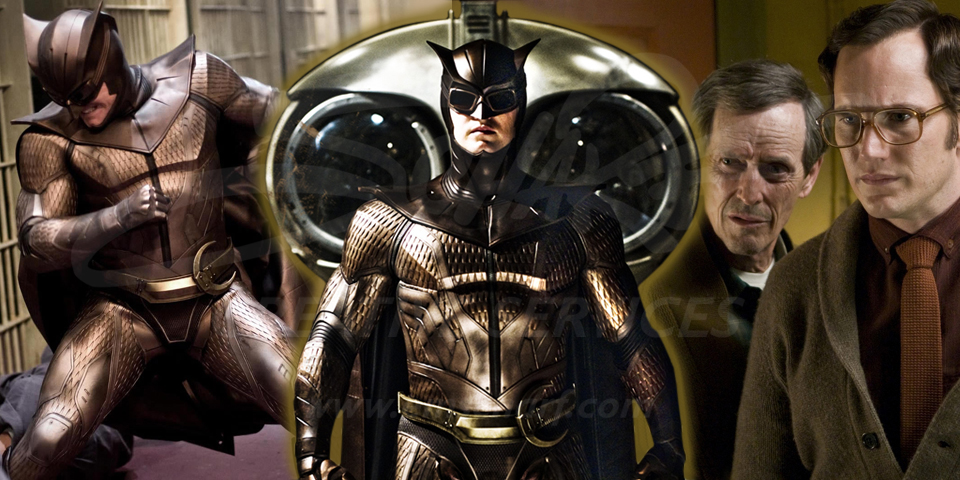
-
-
- Nite Owls situation for all of
his complex gadgetry is the
simplest yet no-less frustrating. Outside his nifty nest
whether tinkering with tech under his two-flat or taking to the night sky
in his awesome aircraft (called Archie, short for Archimedes,
Merlin's pet owl) he is the very capable yet reluctant warrior. Even after having tangled talons with so
many villains, Nite Owl is still uncomfortable in his own
feathers (and admittedly feeling less-than without his
tech). His read-and-react mentality explains why Nite Owl
is content with the relentless Rorschach being
the aggressor. That is, of course, until Rorschach (inevitably)
takes his information extracting tactics too far, causing Nite
Owl to attempt to 'break it up' (and hope Rorschach is
willing
to oblige).
Nite Owl is forced to molt his hesitation in order to help Rorschach
solve the Comedian's murder for the greater good of the team. It took Nite Owl's jump-started relationship with Laurie Jupiter / Silk
Spectre (II) played by Malin Akerman to give him the
confidence to finally break out of his rather impotent
daily routine, succumb to his burning desire to resume the role of Nite Owl
(without fear of government reprisal), and attempt to make a difference alongside his fellow
vigilantes.
-
-
-
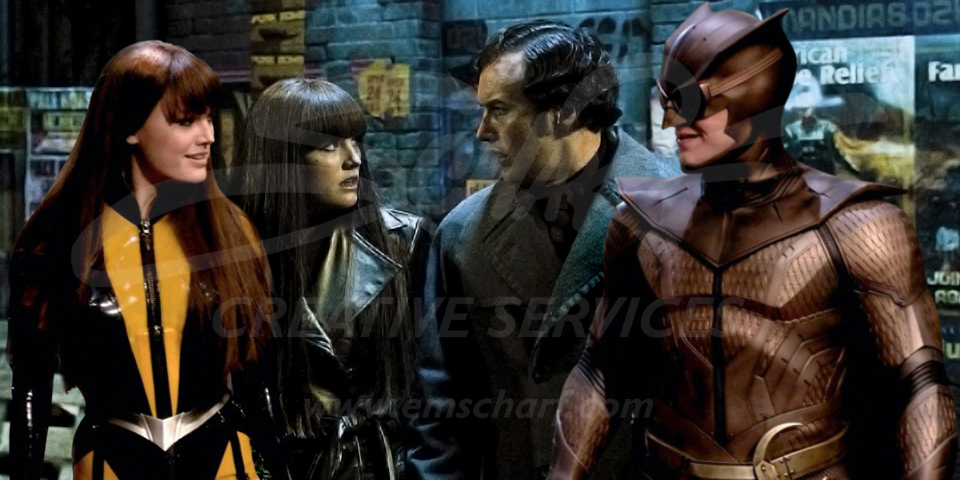
-
-
-
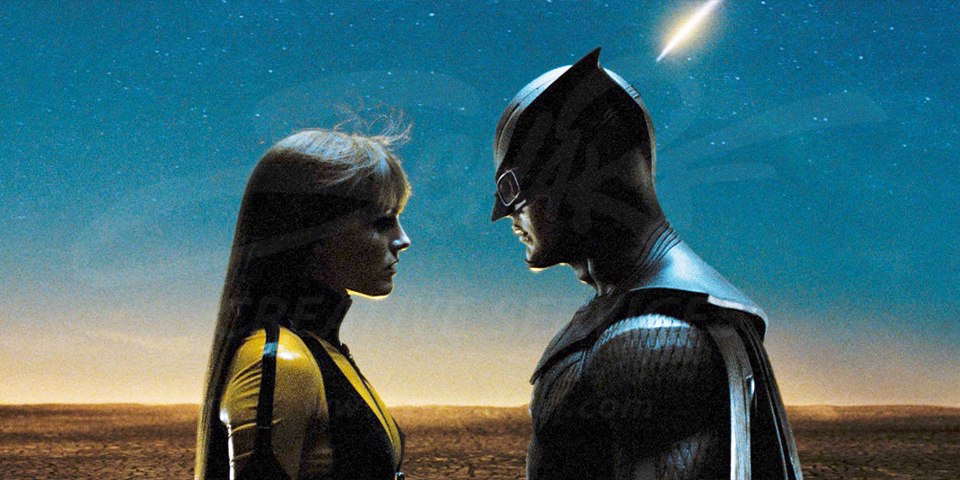
-
-
- Silk Spectre is the one Watchmen
hero who reminds of a child nurtured down a specific
career (path by her single parent) at which she clearly excels even though she may never have been
interested in pursuing it. The story of a great many children
involves the absence of parents who encourage them to (reasonably) find their own
way but when a child is forced to become a super hero, it
seemingly stands in contrast to what the majority of modern day children experience.
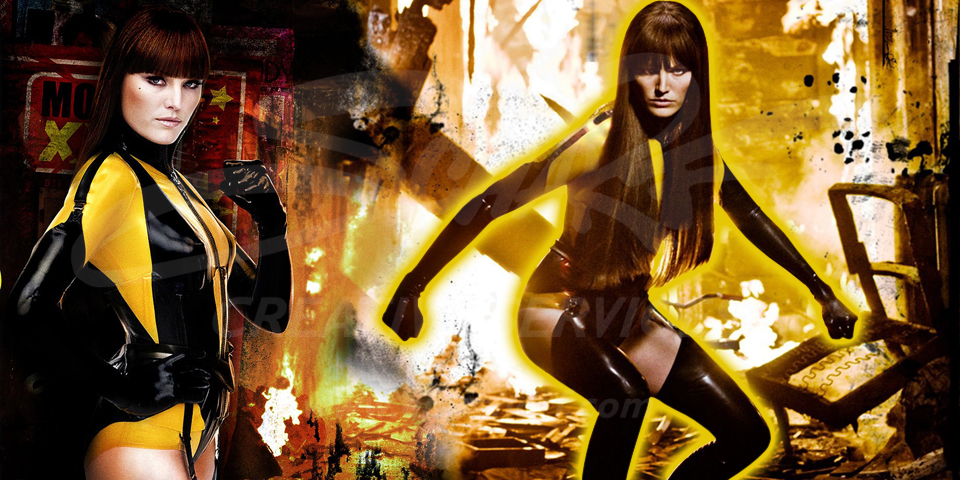
-
-
- Silk Spectre's mother Sally
Jupiter / the original Silk Spectre (played by Carla Gugino) operated as a crime fighter during a time period when liberal women
were not a welcomed part of society. Her mother in her own
way empowered women everywhere to believe they could stand up for themselves, accomplishing more than just the
status quo of the time.
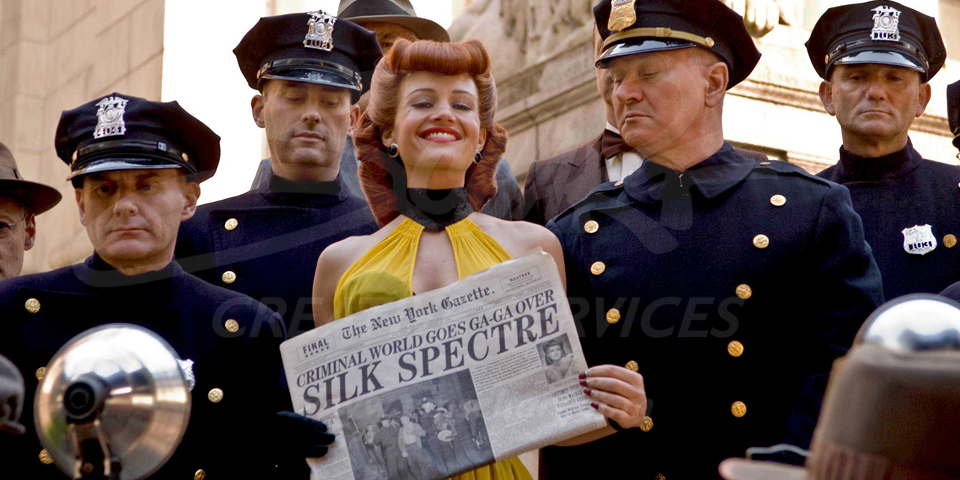
-
-
- Sally was determined to see Laurie follow in her own crime-fighting
footsteps. She (understandably) saw her daughter fair or not,
selfish or not as the very best vehicle for passing on fighting
skills and (eventually) equal / near-equal stature among those who
would be her future male crime-fighting companions. Laurie certainly
has the same refined-and-deadly fighting skills to put the bad guys
in their place, and she looks equally good putting them there, as
well.
One would think that even in mandated retirement the government
might approach her with (secret) agent opportunities of some kind. For all
the skills Laurie brings to the table, however, consider that if not
for being the (hopefully) humanizing love interest of Jon Osterman /
Dr. Manhattan (played by Billy Crudup), and without an eventual Nite Owl connection or any normalized relationship with her
estranged mother Silk Spectre potentially faces a rather isolated
existence.
Never to be confused with Dr. Detroit, what does Dr. Manhattan the most
brilliant-and-powerful entity known to humankind do to remain
interested in Earth, its inhabitants, their commonalities and their
(seemingly petty) conflicts? Does it matter that Dr.
Manhattan spends half of the film transporting himself around town without
so much as a
loin cloth? If you ask him which he prefers boxers or briefs you
might discover that, when you wield as much infinite power as he
does, the basic needs of modern day humanity (food, water, clothing, shelter,
community, education, sense of purpose, transportation) laughably hold
no value. That is, unless a god with a still-intensely-curious
scientific mind is
in need of friendship, companionship, or entertainment from his
former human peers (all but perhaps one of whom he views in the same
way as "the world's smallest flea," but more on that later).
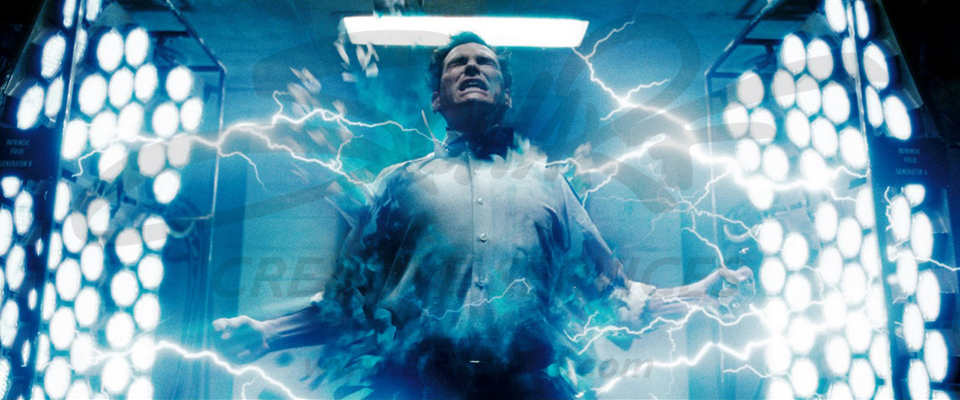
-
-
- The end of his relationship with humanity begins the very moment
scientist Jon Osterman is transformed into Dr. Manhattan by way of
being trapped within a 'Intrinsic Field Subtractor (IFS)' within the
army base where he and his colleagues perform their critical work in the
field of nuclear physics. Osterman's body is disintegrated on the spot,
without a trace. His colleagues grieve, time passes, and then, suddenly,
various internal elements of his body begin reappearing, reconstructing as if lightning strike
hallucinations and with each (frightening to the public) bolt from
the blue more elements compose
themselves and come together . . . until he is finally 'whole' once more.
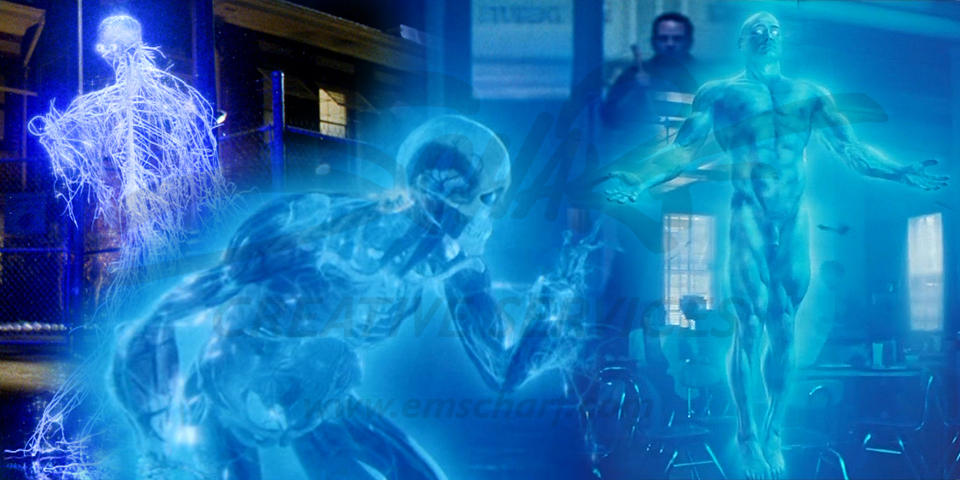
-
-
- The idea
that Osterman does not run, err, float off screaming insanely into the wild
(fluorescent) blue yonder considering his sudden massive awareness of
'everything' around him (including on-demand sight into both his
past and future) is impressive even if the reason is
simply because Osterman is struggling to regain his bearings.

-
-
-
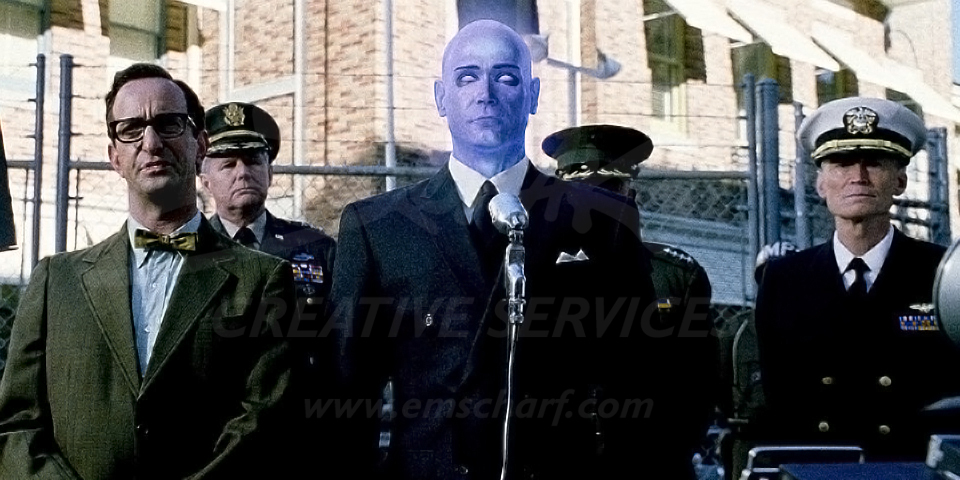
-
-
- Osterman succumbs to the (immediate
but not perpetual) need for
more structure through the 'welcoming arms' of the Department of
Defense (DoD), assuming his desire to blunt his own confusion and receive
exploratory goals towards handling his new-and-terrifying abilities. All the DoD
requires in return for "shaping (Osterman) into something gaudy,
something lethal" is Osterman's willingness to help his countrymen in
times of war to further their weapons development efforts and to
give them his naming rights. He is thusly branded Dr. Manhattan . .
. as a historically horrifying deterrent to enemy nations familiar with the Manhattan
Project.

-
-
- Dr. Manhattan's quickly-achieved control over his galactic gift
triggers the ultimate responsibility of which was referenced
earlier. He can choose to ignore or be of determined purpose to
humanity. He can be good, willfully oblivious, or evil towards a race of largely ignorant,
navel-gazing, self-destructive beings who will forevermore reside on an incalculably
different, lower plane of existence.
This concept
conjures memories of Galactus, the Beyonder, Thanos, Darkseid, and
Uatu the Watcher: all incredibly powerful cosmic entities and each
with a different approach to using and maintaining their abilities .
. . whether or not that involves synthesizing planetoids for
consumption, toying with the lives of simple beings, wreaking
unimaginable destruction, causing merciless death (by the mere
twitch of an appendage), or being a docile observer of such universal events (sworn against
interference unless faced with unfathomable circumstances).
Though
Dr. Manhattan has a gentle bedside manner, he as with his godlike counterparts
ultimately needs (light years of) space from the
'disturbance' or 'irritation' of humanity in order to truly
live. Who would have thought that when you get too big for your britches, you seriously consider leaving your home planet behind, rather than just purchasing a larger pair of pants? While "Planet
Hulk" is not being referenced here, the Hulk certainly would
appreciate the ability to leave "puny [hateful, ungrateful] humans" behind in the blink of
an eye, far more than a fine pair of incredibly flexible pants.
Speaking of colorful characters, The Media Magnate's only mild visual reservation
is with how Dr. Manhattan is
(rather bravely) 'rendered'
in 3D using Autodesk's Maya and Side Effects Software's Houdini
atop a practical, actor-worn lighting rig. Dr. Manhattan's body is an all-CG creation
with a custom, quad-polygonal 3D model (based upon digitized scans of Billy Crudup's face
and fellow actor / model Greg Plitt's
body), all driven by motion capture.
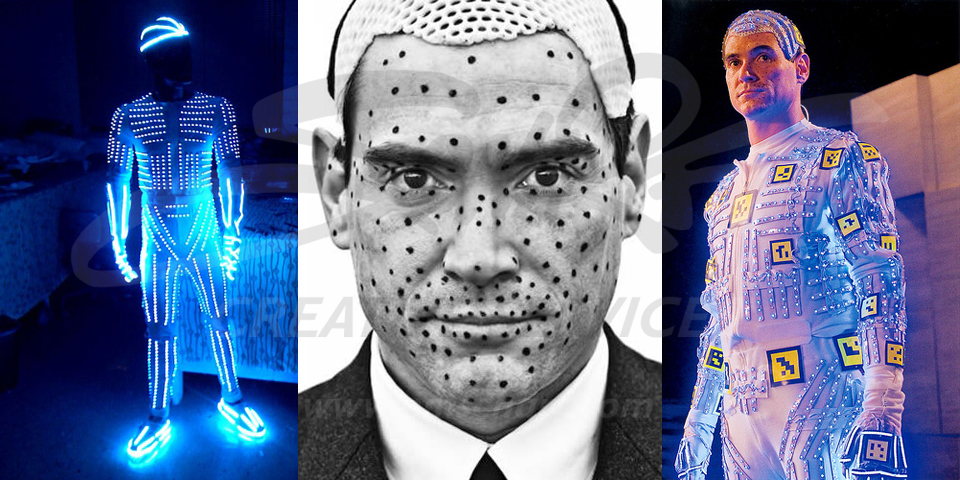
-
-
-

-
-
-

-
-
- It is genuinely understood and
appreciated (from The Media Magnate's own time in the games
industry, using very similar technology and lower-detail visual
assets) just how hard it is to generate and maintain maximum control
over a photorealistic,
self-illuminated, fluorescent blue 3D character without
significantly impacting the lighting requirements of the surrounding
environment, atmospherics, props, and other characters within a live action scene.
A carefully integrated VFX approach as subtle as Dr. Manhattan's
needed to be proves the difference between
near-hit believability and a near-miss distraction. The combined
techniques used by Snyder were worth the risk and produced
admirable-if-understandably-imperfect results.
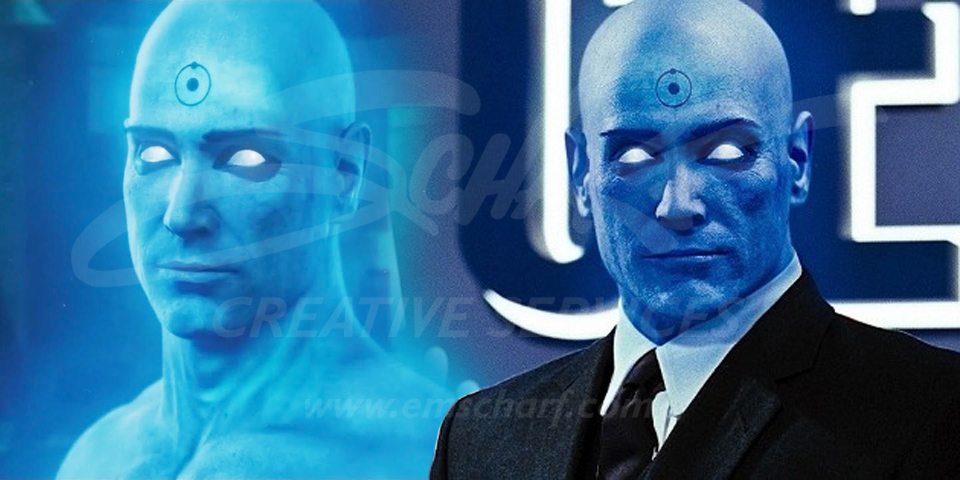
-
-
- Dr. Manhattan
nonetheless and at one point during the film agrees to (slow his
on-camera glow and) be a
broadcast television show guest to answer a series of questions from the
show's host and
live audience. An aggressive reporter within the audience confronts Dr.
Manhattan with probing questions about his past colleagues
(pointing out how everyone with whom he had been in regular contact
since becoming Dr. Manhattan had gotten cancer and died). The
reporter even rolls out Dr. Manhattan's old girl friend Janey
Slater (played by Laura Mennell) who spews venom over her horrible
fate and pulls off an
unexpected wig to gasp-inducing effect.
Dr. Manhattan is caught off
guard by all of this, repeating that he had never been
notified. The reporter and the rest of the audience (seemingly,
stupidly
unfazed that Dr. Manhattan could vaporize them with but a gesture)
rush the stage with flashbulbs-a-popping and more questions. Dr. Manhattan as if
trapped by a suffocating school of fish (finally) snaps.
"Please. If everyone would. just.
go. away . . . and leave me alone. I said . . . LEAVE ME ALONE!"
Dr. Manhattan.
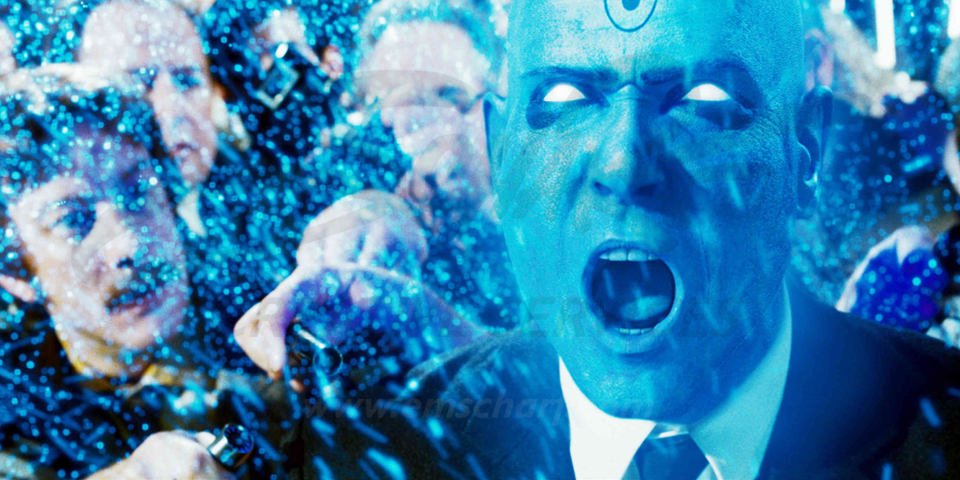
-
-
- Dr. Manhattan teleports himself to
the silence of Mars. Though he easily could have chosen to leave
Earth behind out of (artificially engineered) fear of causing everyone near him cancer,
he was already on the verge of testing the concept of distance making the
heart grow fonder.
"I am tired of Earth. These people.
I'm tired of being caught in the tangle of their lives." Dr.
Manhattan.
Long before Dr. Manhattan determines, however, that he no longer has
a place among humans, he has a number of opportunities to
halt questionable or even horrific actions by both his teammates and
his government, and, yet, he chooses not to get involved. This is
both unconscionable and understandable, and the first real signs the
'human affliction' or 'human condition' can no longer count Dr. Manhattan among its
life-long victims.
Dr. Manhattan still has a moral
compass, and he
knows he can make the biggest difference in a safe(r) future for
humankind. He knows the U.S. and U.S.S.R. are on the bleeding edge of
doomsday,
and yet, as Adrian Veidt / Ozymandias (so smoothly played by
Matthew Goode) says, Not even Dr. Manhattan can be
everywhere at once. So prophetic.
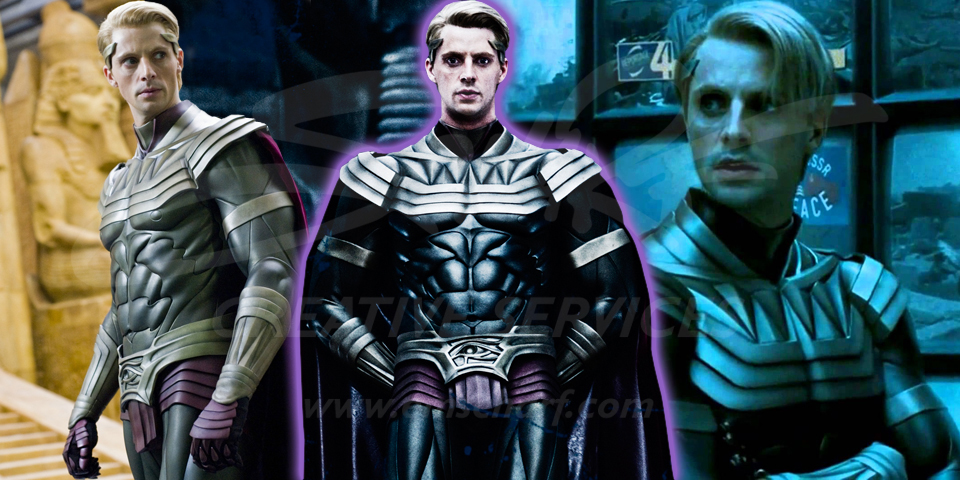
-
-
- Ozymandias having previously
exposed his true identity to the public is one of two Watchmen
(besides Dr. Manhattan) who have no need to hide following passage
of The Keene Act. Ozymandias has made an incredible business empire
for himself (in part from Watchmen-related action figures),
generating exponential insulation from almost anyone or anything on
the planet, public or private.
Ozymandias like Dr. Manhattan has absolutely nothing to
loose, while his colleagues continue to watch their backs even in
seclusion. The same cannot be said for those who visit Ozymandias at
his office building (when in his Adrian Veidt persona), like the
"Big Fossil Fuel" representatives who regarding an aggressive switch
to renewable energy sources come to first complain, then threaten,
then (after a 'subtle' reminder of Veidt's ability to purchase their
businesses three times over) feebly apologize. They are all killed
for their trouble by a hit man who conveniently comes up short
against the superior-skilled Veidt, who comes down hard on the
hit man with one superb swing of a nearby queue pole. The hit man
ingests a poison pill rather making any proclamations before
expiring.
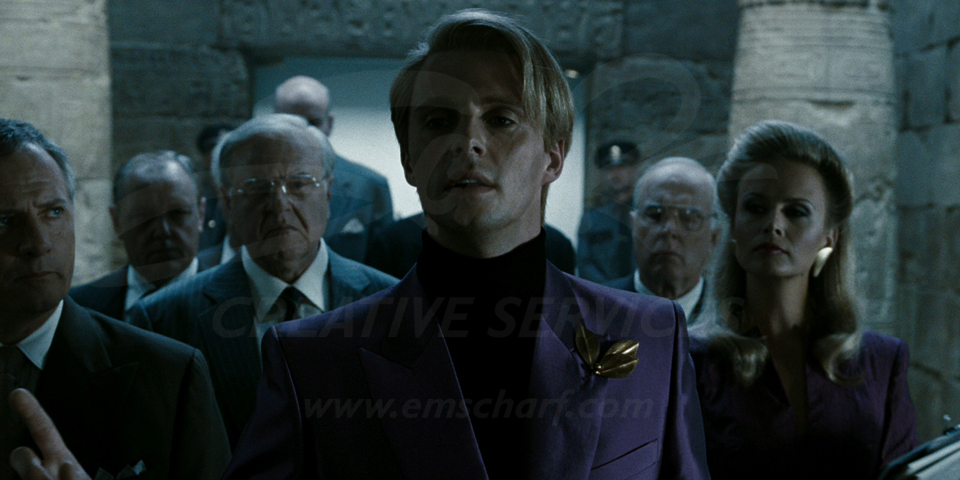
-
-
- While Ozymandias is down one secretary and freed from a fraternity of
fraudulent fossils,
he is already refocused on what he aims to be his defining
accomplishment, his life's work.
One thing still vexes the great Ozymandias, even with
his absolute release from the need for super hero secrecy (though
his need for business secrecy is another story). What does "the smartest man on
the planet" do to scratch a maddening mental
itch? Ozymandias' fascination with one day becoming the modern day
match of his idols Alexander of Macedonia ("Alexander the
Great") and Egyptian pharaoh Ramses II (from whom he procured
his super hero name) ultimately drives him towards his own mad interpretation of
how to attain world peace among near-warring nations. He decides to provide the world's two national super powers
on the brink of nuclear destruction with an unbelievably
convincing incentive to immediately unite towards establishing world peace.
He prepares to deliver his insidious inducement through cataclysmic
devastation normally only associated with nuclear weapons, a 'global
killer' asteroid . . . or one
particular member of the Watchmen.
Ozymandias schemes to use Dr. Manhattans own personal struggle
between remaining on
Earth as humanity's super social worker or
heading out of Dodge to go "where no man has gone before"
to establish the perfect alibi to do the unthinkable.
He aims to destroy major cities around the world, including New York, Los Angeles,
Paris, Moscow, Hong Kong, and Tokyo in
the ultimate attention-getter among squabbling super powers
(specifically the United States and the U.S.S.R.). Dr. Manhattan
in the only end game Ozymandias can envision represents the
perfect scapegoat for his meticulously manipulative plan.
Dr. Manhattan is impervious to any physical threats from humanity.
He is kind to humanity (or at least the U.S. and their western allies),
but kindness can diminish to mere tolerance, and mere tolerance
in the blink of a super-powered eye can transition into
cleansing the home world of a ridiculously self-destructive race. He represents
the
common denominator required to forcibly bring two adversarial
'superpower' countries
and many other smaller players together towards formation of the ultimate peace
accords.

-
-
- Ozymandias enlists a group of top scientists
to collaborate remotely with Dr.
Manhattan on a "clean energy project." His scientists operate from
within the isolated confines of Ozymandias' Antarctic fortress, Karnak
(named after Egypt's "Valley of the Kings") with the collective goal
of designing and constructing an "Intrinsic Field Subtractor (IFS)," similar to the one that originally transforms Osterman
into Dr. Manhattan . . . but which critically mimics Dr. Manhattan's
energy signature and teleportation ability.
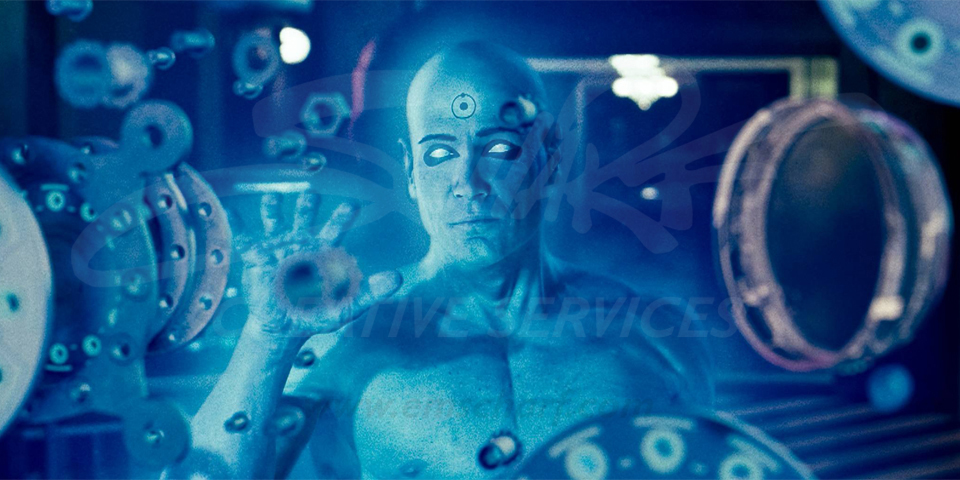
-
-
- Once the IFS is operational, Ozymandias intends to
dispose of his hired help using the shiny new coffin they
have unwittingly designed for themselves.
Ozymandias aims to frame (the relentless bloodhound) Rorschach
for the Comedian's murder before he can unmask how it is Ozymandias who, in fact, ends the hilarious hit man (who
discovers his sinister plot at the specific request of Tricky Dick
Nixon). And that it is Ozymandias who pays-and-kills his
would-be assassin with a cyanide pill. And, AND how it is Ozymandias who
also
kills the cancer-stricken former super villain, Edward Jacobi /
Moloch the Mystic (played by Matt "Max Headroom" Frewer)
in whom the suddenly cracked-and-crying Comedian confides his
world-shattering realization. And, AND, AND
how Ozymandias causes Moloch, as well as Dr. Manhattan's friends,
colleagues, and handlers Janey Slater, Wally Weaver (played by
Rob LaBelle), and General Anthony Randall to also die of cancer.
Ozymandias would then teleport in, trigger, and
teleport out the IFS to progressively, respectively destroy New York, Los
Angeles, Moscow, and Hong Kong . . . in order to frame Dr. Manhattan
as the undeniable source of the worldwide devastation.
Most critical to keeping the electric blue foundation of Ozymandias'
devastating design in a reliable mindset is the placement of tachyon particle
generators throughout the Washington, D.C. area from at least the
beginning of the IFS construction and through the end of
intercontinental
destruction. The presence of these devices prevents Dr. Manhattan from seeing (or
distinguishing current events from) his own future. This masking of
his 'timeless sight' restricts Dr. Manhattan to only those events which
he experiences in real-time and (as Ozymandias hopes) could cause him to
finally decide humanity is unworthy further
'encouraging' him to pursue permanent self-exile from Earth as his only
non-violent escape (from humanity's boorish violence), and
perhaps of greatest value to Ozymandias . . . no (further threat of) interference from
the only being really capable of dooming his design.
Assuming no unexpected gotchas derail his mad scheme too soon, Ozymandias
will attempt to convince the other Watchmen of the bigger, better
picture and to keep this most horrible secret from
the rest of humanity (rather than risk an unthinkable doomsday clock relapse), and if they fail to appreciate his grand vision he will kill them to ensure
silence.
While Ozymandias is
busy unwinding his twisted tale, Rorschach and Nite Owl are
aggressively following (surprisingly sloppy) bread
crumbs back towards Pyramid Transnational (a subsidiary shell
company of Veidt Industries under which Ozymandias has been coordinating his
entire plan).
Ozymandias underestimates just how quickly Nite Owl and Silk Spectre
decide to throw Keene-Act-caution to the wind and attempt to break
Rorschach out of prison (where he is, of
course, held after Ozymandias frames him for Moloch's murder).
Following their
successful retrieval of Rorschach during a prison riot in which
Rorschach 'saw handfuls' of activity and they
return to Nite Owl's nest to regroup.
Dr. Manhattan suddenly reappears
from his Mars meditation just in time to ruin a gentle kiss
between Nite Owl and Silk Spectre. Time away from mind-numbing tachyon
interference clears Dr. Manhattan's head, finally allowing him
enough focus to urgently approach Silk Spectre about a forthcoming
discussion.
"You're going to try to convince me
to save the world." Dr. Manhattan.
Silk Spectre agrees to go back to
Mars with him under unknowing protest from Nite Owl. Dr. Manhattan
transports her to Mars and within immediate view of a mammoth animated
crystal time piece (harkening back to memories of his youth and the
mechanical teachings of his watchmaker father). Dr. Manhattan is 'slow' to envelope her
within a
breathable air pocket, drawing further attention to his potentially expanded
disconnect from humanity.
Silk Spectre is already angry with him and
demands he just cut to the chase and confirm whether or not nuclear
destruction is imminent or humanity survives to continue on its
imperfect journey. He shares that from what future bits and pieces
he can finally see she ends up in tears and "the streets are filled with
death." She implores him to return to Earth to prevent
mutually-assured destruction.
Dr. Manhattan explains that he
merely sees life on life's terms, but that she refuses to see things
from his perspective, that she shuts out the things she
fears. Silk Spectre dares him to "do that thing you do" and
expose her to his omniscient memories. After obliging her demand,
they both exit his forced
flashback emotionally distraught. She is in tears over the realization
her father was the Comedian, and Dr. Manhattan is in shock over the
realization he is wrong about miracles (of life) and humanity's
ability to create them.
Her birth from as contradictory a union as rape was a miracle, and that creating life is "like turning gold into air."
While the miracle of life would seem to be a completely obvious
thing to a being like Dr. Manhattan, it is entirely possible the
stench of humanity's extremely poor showing on the cosmic stage (let
alone Earth) may so disgust him from making any
further effort to help save the human race . . . that it takes an equally ugly thing in
the rape of a woman for him to see the value in humanity's
imperfect and unpredictable ability to create life.
Dr. Manhattan
returns to Earth with Silk Spectre to fulfill one last promise
to her, and make one final doomsday-diverting delivery to a
still-undeserving humanity.
They appear in New
York City and before he can act, however humanity appears to
have beaten him to the punch. A significant portion of the city has been
obliterated by what appears to be a nuclear blast (to the untrained eye
straining to view imperceptible differences). The DoD
almost immediately determines (by energy signature alone) the chaos
could only have been caused by Dr. Manhattan (who to the contrary finally
notices the tachyon interference that has been preventing him from realizing
what has really been occurring since the beginning of his IFS
collaboration with Ozymandias). He explains to Silk Spectre that he
has been framed by Ozymandias, and he instantly teleports them to
Ozymandias' Antarctic compound to confront him.
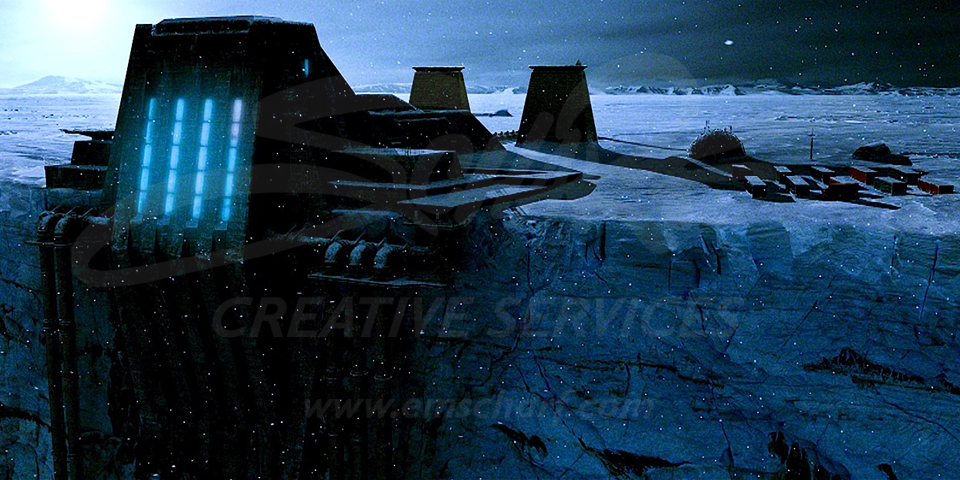
-
-
- Upon their arrival, Dr. Manhattan
and Silk Spectre see Nite Owl and Rorschach, who had arrived earlier and come to the same
conclusion (albeit by breaking into Ozymandias' office, gaining access to his
computer's database through some timely password tinkering and
shockingly connecting all the bytes to Pyramid
Transnational).
Nite Owl and Rorschach think they
have Ozymandias surrounded and outnumbered, but Ozymandias easily dismisses their initial
assault with his incredible reflexes. It seems he is either a great "Remo Williams"
impersonator, or his genetically-engineered pet lynx, Bubastis, was not the only thing he genetically
created or enhanced.
-
- Dr. Manhattan nonetheless marches
up a main staircase past Nite Owl
and Rorschach. He hears but does not heed their warnings, and asks them to stay put
(knowing full-well Ozymandias may yet have more devastation on tap
for the only being capable of stopping him). Dr. Manhattan makes his
way into a suddenly tight corridor for such an open compound as Karnak. He is kept momentarily preoccupied by Bubastis.
-
-

-
-
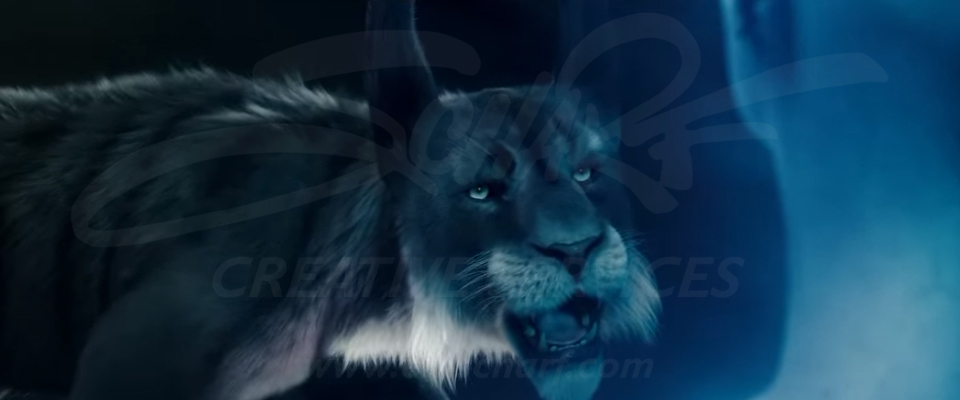
-
- The sight of Bubastis as a brief
aside was a pleasant
surprise versus what would have been an understandable VFX
dodge.
-
- Nonetheless, it is in this moment
that Ozymandias quietly asks for Bubastis' forgiveness as he flips
the fatal switch to the IFS, hoping but not knowing if the
kind of construct that can create Dr. Manhattan can also obliterate
him.
-
-
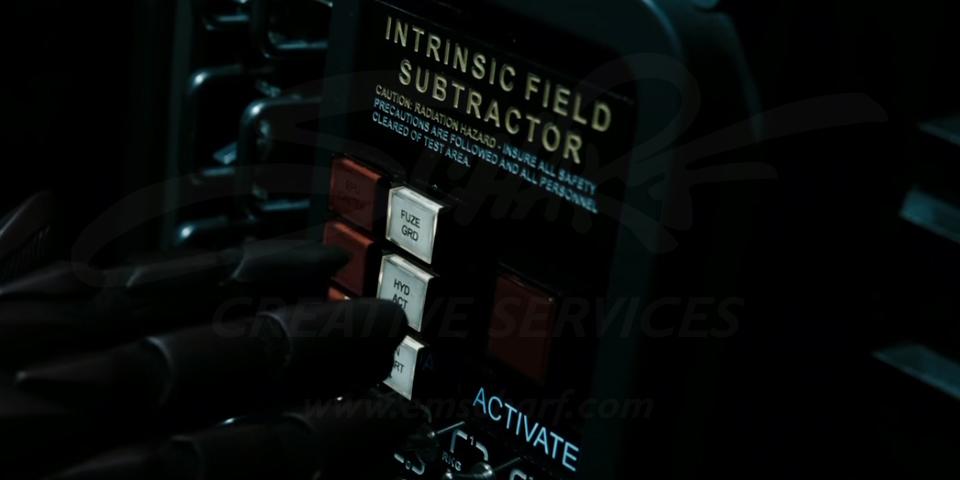
-
- Dr. Manhattan seems prepared for and completely at peace
with
Ozymandias' perceived master stroke, while Bubastis can only
helplessly growl in protest at her own disintegration. It takes but a (long)
second to occur . . . and they are gone.
-
-
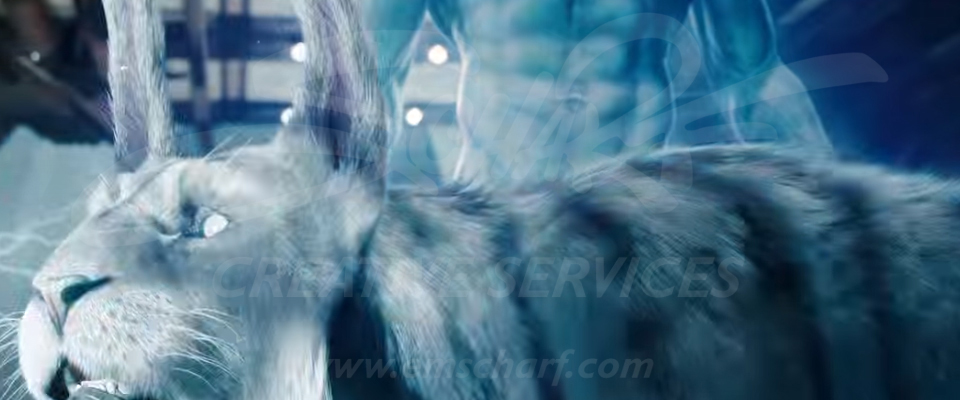
-
-
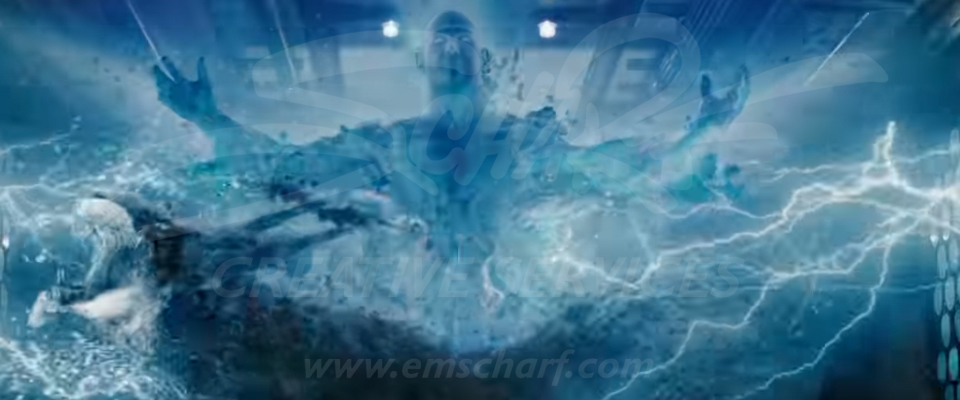
-
- Dr. Manhattan seemingly can as he says "turn the walls (of the IFS) to glass." Perhaps
he is curious as to Ozymandias' next steps, and he is willing to expose
himself to a cataclysmic conclusion in order to learn Ozymandias'
true end game.
-
- Perhaps Ozymandias also employs
tachyon interference devices within Karnak, as well, continuing Dr. Manhattan's inability to retain full mental control and focus.
After all, Dr. Manhattan could have floated rather than take the
stairway up into the IFS chamber.
-
- Perhaps his reaction is another
example of his growing disconnect from humanity, which reminds of
the scene following the Dr. Manhattan-powered U.S. victory over
the Vietcong where the Comedian is confronted by a Vietnamese
woman he impregnated. She wants to know what he is going to do
about their baby. The Comedian wants nothing to do with the
situation, talks down to her, and tries to dismiss her. She has none
of it, breaks a beer bottle, and slashes the Comedian's face. He
draws his gun and takes aim as if she is just another member of the
Vietcong.
"Blake, don't.
BLAKE! She was pregnant . . . and you gunned her down."
Dr. Manhattan.
"That's right. And you know what?
You WATCHED me. You could've
turned the gun into steam, the bullets into mercury, the bottle
into goddamn snowflakes. But you didn't, didja'? You really
don't give a damn about human beings. You're driftin' outta' touch,
Doc. God help us all. MEDIC!" the Comedian.
Ozymandias after seemingly
succeeding in obliterating Dr. Manhattan reappears at the top of
the staircase within Karnak's main chamber, to the shock of Nite Owl, Rorschach, and Silk Spectre (who decides to dispense with
the awesome, collective show of hand-to-hand combat in favor of a
point-blank gunshot at their longtime teammate-turned-enemy).
Ozymandias to everyone's surprise
goes tumbling down the staircase, sliding to a limp-bodied
halt. Their surprise is shattered as Ozymandias reveals
he caught the bullet with a well-padded glove, as he suddenly side-thrust-kicks Silk
Spectre several feet up the staircase where she sustains a brutal
landing.
In one of the best, most painfully
dismissive lines of super hero film history following Nite Owl's threat to kill
Ozymandias if Silk Spectre has been severely hurt by him the always aloof, deadpan Ozymandias says,
"Grow up, Dan. My new world demands less obvious heroism. Your
schoolboy heroics are redundant. What have they achieved? Failing to
prevent Earth's salvation is your only triumph."
The Media Magnate as an aside and in that moment felt as helpless as Nite Owl looked
in his part of the failed 3-on-1 bid to take down Ozymandias. One
might argue the Comedian many years older than Nite Owl with
similar-to-superior fighting skills at least
put up a real fight to begin the film. Still, Ozymandias toyed with the
attack-minded Comedian like a cat with a ball of yarn in the process
of easily bloodying him before single-handedly (yes, with a
SINGLE hand) raising him off the ground "light as a feather,
stiff as a board" style and mercifully (?)
tossing him through a plate-glass window to his height-accelerated,
bean juice-covered death.
This tone-setting scene for those familiar with
the original fiction would appear to indirectly reference "The Veidt Method," a concept of body-and-mind development practiced by Ozymandias
(and publicly advertised by Adrian Veidt) as THE way to achieve and
maintain one's peak mental and physical skills.
The Veidt Method would seemingly be
one of only two unadvertised-by-Snyder reasons for Ozymandias' lightning fast, Remo Williams-like reflexes and superior
physical strength, with the other reason being that Ozymandias'
genetic experimentation may not have been exclusive to the creation
of his pet lynx.
Nonetheless, just when Nite Owl,
Rorschach, and Silk Spectre potentially begin to loose hope in their
collective ability to topple Ozymandias, a familiar voice booms from
above. Both heroes and villain alike suddenly look up to see a
towering, monster movie-sized Dr. Manhattan staring down at them
through the no-longer-so-massive-looking skylight in the facility's ceiling. His hand
like a wrecking ball with bad intensions smashes
through it and barely misses a diving Ozymandias.
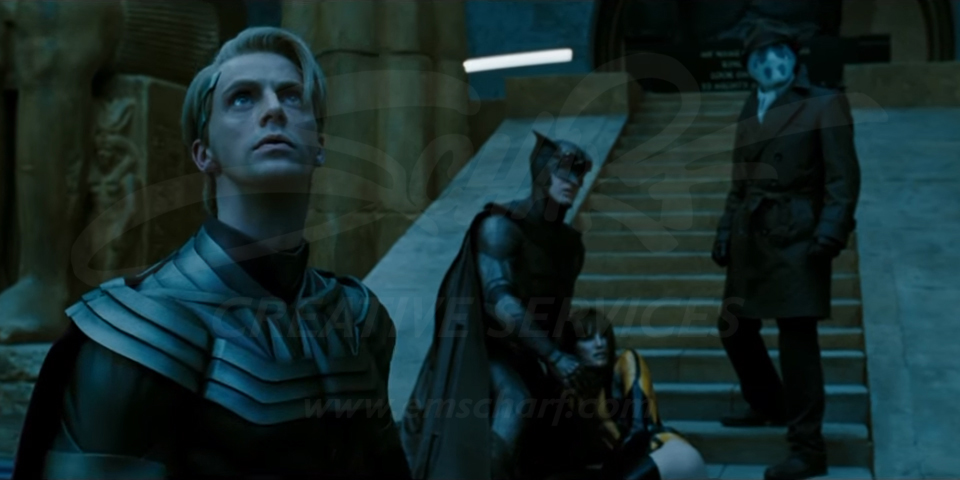 -
-
 -
-
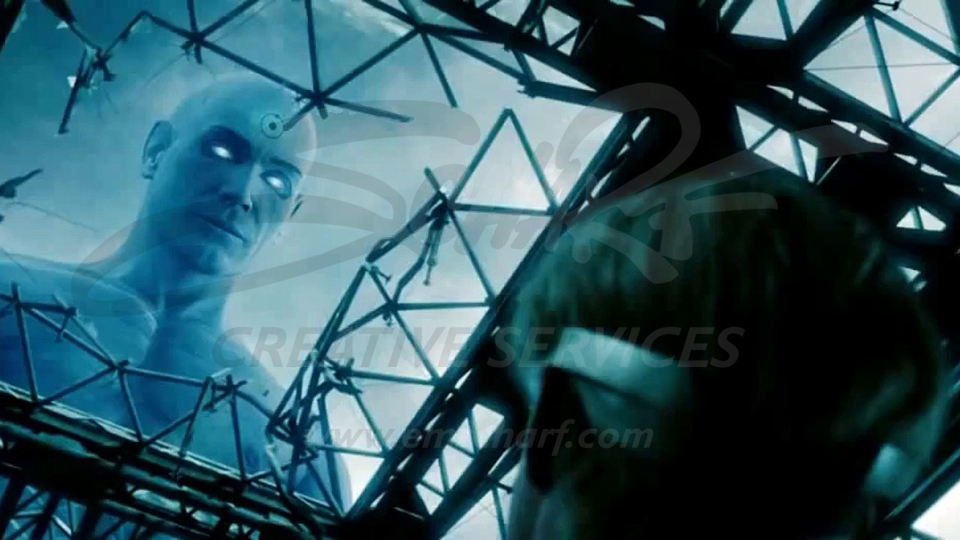 -
- "Reassembling myself is the first trick I learned. I didn't kill
Osterman," says Dr. Manhattan as he returns to normal size and
approaches his team member-turned-adversary.
-
- "Did you really think it would kill me? . . . I have walked
across the surface of the sun. I have witnessed events so tiny and
so fast they can hardly be said to have occurred at all. But you,
Adrian, you're just a man. The world's smartest man poses no more
threat to me than does it's smartest termite." Dr. Manhattan.
-
-
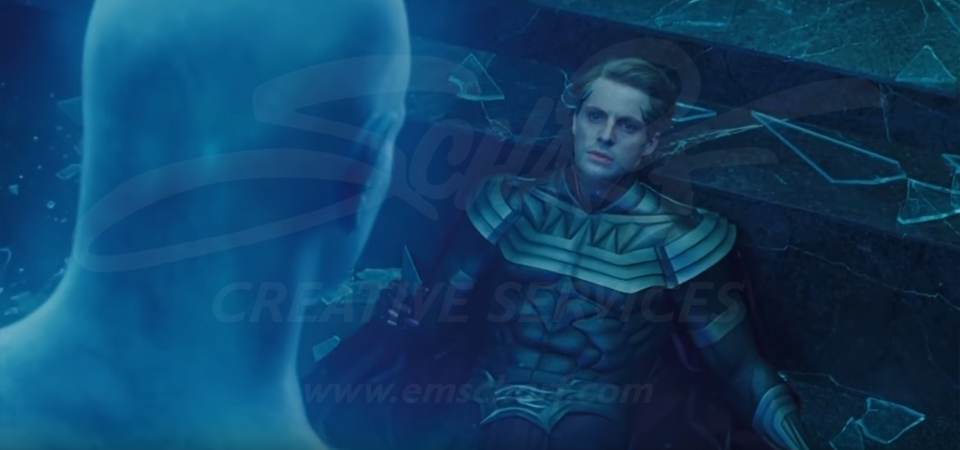 -
- As another brief aside, this scene faintly reminds The Media Magnate of
one of the final (powerful) scenes from "Bladerunner," involving Rutger Hauer's replicant "Roy Batty" and Harrison Ford's
"Rick Deckard."
-
-
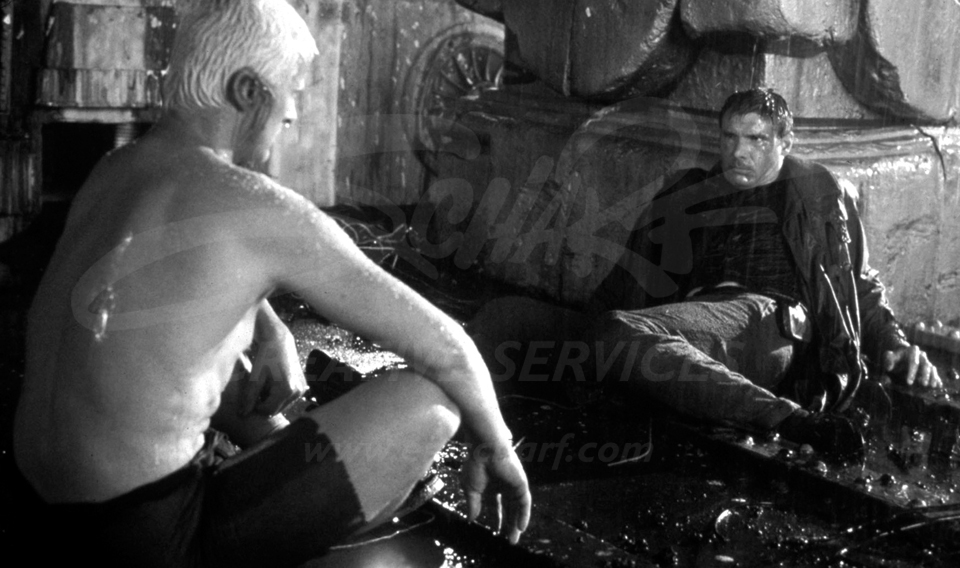 -
- "I've seen things you people wouldn't
believe. Attack ships on fire off the shoulder of Orion. I watched
C-beams glitter in the dark near the Tannhδuser Gate. All those . .
. moments will be lost, in time, like tears, in rain. Time to die."
Roy Batty to Deckard, after sparing him from an equally deadly
fate.
-
- Ozymandias nonetheless and seemingly seconds
away from oblivion is holding up a handheld device
to which an unimpressed Dr. Manhattan responds: "What's that? Another ultimate
weapon?"
"Yes, you could say that," says
Ozymandias, who manages an uneasy grin (knowing he has been
similarly spared) as he presses a button on what
proves to be a TV remote. The bank of televisions he had previously
been watching suddenly attract everyone's attention with footage of
President Nixon confirming the inconceivable news, and that
like the rest of the developed world he has been fooled into
believing Dr. Manhattan is to blame.
It is in this moment that moviegoers
come to truly realize the tremendous potency of the tachyon interference, or recognize the astonishing naοvetι of a god-like being who is
expected to
know better in Dr. Manhattan. He would seemingly never allow
anyone or entity friend, foe, or friend-turned-foe to
successfully replicate his powers.
- The world's smartest termite indeed 'wins' the day . . .
insidiously sparing humanity from paying the ultimate price at a still-terrible cost.
-
- Ozymandias has degenerated
himself from being the most brilliant human on Earth to a person
terminally desperate to deliver the no, his ultimate
peace-brokering solution (but not a guaranteed or permanent one
due to the ever-present, unrelenting human condition that has
historically stunted society's ability to achieve greater harmony). He
in his madness determines there is also no better choice than to ruin the good name of
the most brilliant, powerful, capable, and docile-unless-provoked being known to humanity, encouraging the world to believe that Dr. Manhattan has
murdered millions of people in a fit of rage (as an extremely
convenient cover for the distributed blast from the IFS) just
so the threat of nuclear war could potentially be stopped
forever.
The Media Magnate sees a (very) loose connection between this result
and the final scene of the "The Dark Knight" the 2008 second leg
of Christopher Nolan's Dark Knight trilogy, when Harvey Dent
rather than dying a hero lives long enough to see himself become
the villain.
-
- "(Harvey Dent's) the hero Gotham deserves, but not the one it
needs right now (because the city can never know the truth). So we'll hunt (Batman). Because he can take it. Because he's
not our hero. He's a
silent guardian, a watchful protector. A dark knight."
-
-
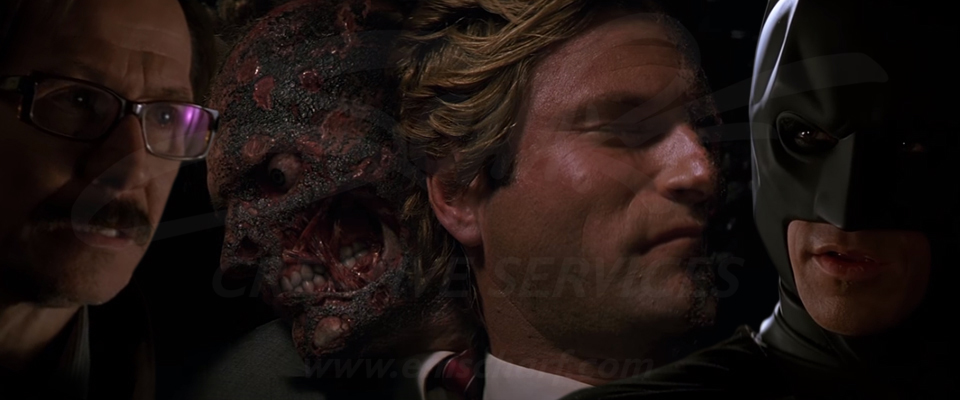
-
- A similar sentiment with a twist exists in "Watchmen,"
with Dr. Manhattan being set up to take the blame for the
devastation wrought by Ozymandias.
-
- "Babysitting a society of troglodytes pretending to be members
of a civilization is not the responsibility Dr. Manhattan deserves, not
the headache he needs right now. So humanity will hate him, because
our trigger-happy superpowers can never know the truth. Because he can
take it in order to maintain the impossible achievement of a grand lie. Because he's not
our hero or one we have earned." as would have been
appropriately and privately stated by Ozymandias.
"I am tired
of Earth, these people. I'm tired of being caught in the tangle of
their lives." Dr. Manhattan.
-
- It is sad that such a brilliant mind as Ozymandias' succumbed to
the very brutal ironies mentioned at the top of this review. He wants
to save humanity from the potential of total annihilation, taking
measures that would only exist within the nuclear holocaust he seeks
to prevent, and, yet, he is performing this act for a society he
not-so-secretly
loathes.
Consider that Ozymandias has also come to this deadly conclusion to
forgive himself for failing to find a peaceful solution towards bringing
humanity together. He must feel as limited and helpless as the
normal, fellow human beings he despises. Then, again even though
it never appears to be part of his plan Dr. Manhattans exit
reasonably ensures Ozymandias will never again be or feel challenged by an
equal or superior intellect / higher power . . . until Dr. Manhattan's
unlikely (?) return, of course.
-
- Through the irony of all ironies, Dr. Manhattan and Ozymandias
deserve each other. Ozymandias uses tachyon radiation to block Dr.
Manhattans visions of the future, and, yet, we
have no way of knowing whether or not Dr. Manhattan had already seen
the future before his visions were blocked. Thus, Dr. Manhattan
could have, should have, but only might have stopped Ozymandias from
making his devastating decision.
Dr. Manhattan could have also
directly or indirectly prevented the Comedians death, and, by doing
so, Dr. Manhattan could have also prevented his own final (?) act on
Earth from being the mercy killing of Rorschach, who felt
totally betrayed when the most responsible human he knew,
in Ozymandias, could no
longer maintain his righteous separation from the abysmal humanity
both of them loathed, and in which Dr. Manhattan no longer had any
interest.
Superheroes again and regardless of how powerful always seem to be faced
with the perpetually impossible challenge of being more human than human, without becoming
inhuman. The Watchmen are doomed to self-destruction from the
beginning, leading to inhumanity in the end, but this is not because
they did not try mightily to avoid such a result.
Some
filmgoers were anticipating another superhero film for the sake of
superheroes, and Watchmen could not be farther from that kind of
experience. Other filmgoers wanted to see something that properly
honored the material on display in Alan Moores 12-book mini-series.
While Snyder took calculated risks for a number of reasons (some
filmmaker practical, some studio executive questionable, and shared
implication for others) like so many directors before him and still
to come his effort was a near panel-by-panel replication of
Moore's material. For those who felt Snyder's effort was still
deficient or unreasonably inaccurate, Good luck
with that in a near 3-hour time span. Still, others were looking
for a healthy mix of both which left the result as firmly planted in reality as possible. Just
like viewing a Rorschach, almost everyone sees something different and in
the case of Watchmen purists and critics (unfamiliar with the
original fiction) wanted to see something different.
-
- The Media Magnate drank deeply of Snyder's adaptation and is
eager to see how his detailed direction might measure up with other
cherished comic book properties.
-
- Right or wrong, good or bad, fair or unfair, cinemagoers should
steel themselves for the Pandora's box that Snyder's effort may have
irreversibly opened: comic book film adaptations that involve an
increasingly in-depth marriage of two former foes . . . superhero
wonderment and (sometimes painful) reality.
|